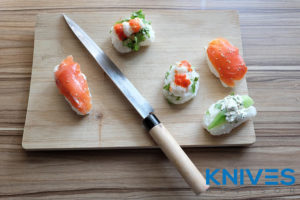While most people are happy with a general set of knives in their kitchen, that is not the case for enthusiastic cooks or professionals working in the catering industry. There are many different styles and sizes of knives that have specific purposes. Their shape, thickness, sharpness, and general design determine the tasks for which they are most suitable.
Japanese cuisine is a style of cooking that requires specialist knives to create some of their most famous dishes, including sashimi and sushi. The following is a guide to the things you need to consider when buying best sashimi or sushi knives along with an overview of the different types of knives available.
Quick List of The Best Sashimi/Sushi Knives
- JapanBargain S1560 Japanese Yanagiba Sashimi Knife
- Mercer Culinary Yanagi Sashimi Knife
- Yoshiri VGYA270SH Hongasumi Yanagi Knife
- SETO Japanese Sashimi Knife
- Sunlong Damascus Sashimi Sushi Knife
- DALSTRONG Yanagiba Knife
- Mac Knife Japanese Series Non-Stick Sushi and Sashimi Knife
- Cangshan J Series Steel Sashimi Chef Knife
- Masahiro Stainless Yanagiba
- Seki Gold Kotobuki St Sashimi Knife
- Global Two-Sided Sashimi-YO Slicer
- Paderno World Cuisine Yanagi Sashimi Japanese Sushi Knife
Quick List of Best Sushi Knives Sets
- Hiroshi Knives 4-Piece Sushi Knife Set
- Mr. Takaaki Nakamura Japanese Kitchen Knife Set of 5
- Happy Sales Set of Three Japanese Sushi Chef Knives
Best Sashimi Knives – Product Reviews
If you decide that you prefer to buy individual knives, you will find an excellent selection of top-quality knives available. Here are 12 of the best sashimi knives currently on the market.
1. JapanBargain S1560 Japanese Yanagiba Sashimi Knife
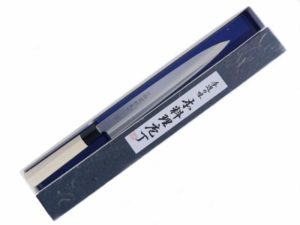
This is probably the best Japanese sashimi knife if you want something that is versatile for creating sushi at home. It is a large yanagiba at 300mm blade width and is 11.75-inches long. This means it is perfect for cutting a range of ingredients, including fish, meat, and vegetables. It is also the best knife for cutting sushi rolls. The blade is made from molybdenum steel, which is super sharp, rust-resistant and easy to sharpen. It is comfortable to use, thanks to the smart wooden handle and plastic bolster.
Quality Materials:
The molybdenum steel from which these knife blades are made means they are very sharp and will cut cleanly through fish and meat. The quality of the wooden handle gives a comfortable grip, so the knife is easy to use.
Easy to Maintain:
The plastic bolster means that the handle section is not contaminated by food, which keeps the knife sanitary and it is easy to clean. The knife is also easy to sharpen, so you do not need to waste time regularly sharpening the blade.
Storage Case:
This knife comes with a storage case, so you can keep it safe and dry when it is not in use. This will extend the life of your knife as it is less likely to suffer damage. It also increases your safety as you do not need to store the knife with the blade exposed.
2. Mercer Culinary Yanagi Sashimi Knife
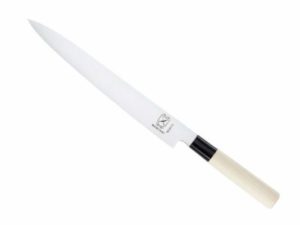
One of the best Japanese Sashimi knives, this razor-sharp 10-inch knife can cut easily and cleanly through raw meat and fish. The blade is made from high carbon and has a single edge. Customers who buy this knife have a choice of handles, depending on their personal preference.
Quality Blade:
The blade is a high-quality high-carbon with a razor-sharp edge. The German steel is resistant to rust, discoloration, and corrosion. It has a single-edge blade that is taper ground and has a fine stone finish. This means it slices through raw meat and fish just as easily as if it were slicing through butter.
Choice of Handle:
Customers can choose between two handles, either a traditional wooden handle or an NSF certified Santoprene handle that is slip-resistant. This means you can choose the style of handle that gives you the most comfort and you prefer to use.
3. Yoshiri VGYA270SH Hongasumi Yanagi Knife
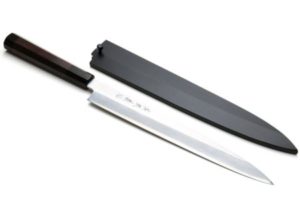
These knives have a 10.5-inch Hongasumi grade blade that is both durable and sharp. It easily slices through raw fish and meat without leaving any jagged edges, so they are a good sushi knife for general use. This is an elegant looking knife with a stunning handle. These knives are easy to clean and maintain, so they are an excellent addition to your knife collection.
High-Quality Blade:
The blade of this knife is made from Hongasumi grade high-carbon steel that is durable, exceptionally sharp, and stain-resistant. The edge of this knife has a long edge life and is easy to sharpen using Japanese whetstones.
Exceptional Handle:
This knife’s handle is stunning. It is handcrafted Japanese octagonal rosewood shitan with a lacquer coated magnolia sheath that is stain-resistant and odor-proof.
Well-Constructed:
It is a well-constructed knife that has a double ebony bolster. This contributes to the light and well-balanced construction of this knife.
4. SETO Japanese Sashimi Knife
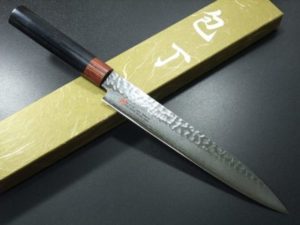
Handmade in Seki, Japan, this is a high-quality knife with a blade made from forged steel. The blade is patterned, so it is a stylish looking knife. It is produced by Mr. Yoshinori who is not only a representative of the SETO YOSHI knife company, but he is also a member of the Knives Maker’s Guild in the United States.
Quality Blades:
The handmade and patterned blades are made of top-quality forged steel that is durable, sharp, andeasy to sharpen. It has a beautiful finish that you would expect from this reputable brand.
Nice Handle:
Its handle is red sandalwood with a plywood bolster. This means the makers have created a handle that is both stylish and lightweight.
Presentation Box:
This knife comes in a smart presentation box. However, this has a practical purpose and is not just for visual appeal. It will keep your knife clean and dry while also providing safe storage so that the sharp knife blade is exposed.
5. Sunlong Damascus Sashimi Sushi Knife

This is one of the top Japanese sashimi knives and is manufactured by a reputable brand. The 8-inch patterned blade is extra sharp and made from quality Damascus steel. The shaped rosewood handle looks smart and is finished off with a stamped metal disk. The knife comes in a smart presentation box where you can store the knife when not in use.
Sharp Blade:
The corrosion-resistant, patterned Damascus steel blade is 2.5 millimeters thick with a super sharp edge. It is double-edged, so you can use it with either your left or right hand. This knife will easily slice through raw fish or seafood and is one of the best knives for cutting sushi rolls.
Shaped Handle:
The shaped handle on this nice means you will always have a comfortable grip while slicing sashimi. The inner of the handle is die-cast molded, while the outer is made from high-grade rosewood.
Safe Storage:
It comes in a presentation box that you can use to safely store your knife so that there are no sharp edges exposed in your kitchen drawers.
6. DALSTRONG Yanagiba Knife
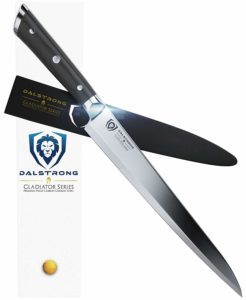
Designed to create ultra-thin and ultra-precise slices of sashimi, this high-quality 10.5-inch knife is perfect for preparing raw fish, but you can also use it for meat and slicing sushi rolls. The ergonomic design of the knife makes it easy to use while giving excellent results. It comes with a blade cover, which protects the blade from damage and increases safety as the blade is not exposed when the knife is not in use.
Laminated Handle:
The pakkawood handle is imported from Spain and crafted in an ergonomic design that increases comfort during use. It is laminated to improve sanitation, to increase water and stain-resistance, and to give the handle extra strength.
Good Construction:
The bolster is hand polished and adds a counterweight to the knife while the triple rivets give more strength to this robust knife.
Quality Blade:
The high-quality blade is made from high-carbon ThyssenKrupp German steel and is 3.5 millimeters thick with a super sharp edge. This means it slices neatly through the fish or meat and then pushes it away from the blade.
7. Mac Knife Japanese Series Non-Stick Sushi and Sashimi Knife

An 8.5-inch knife, the blade is made from molybdenum steel and is two millimeters thick. It has a long edge life, so you will not need to waste time repeatedly sharpening the edge to keep it sharp and working effectively. This is a smart-looking knife with a pakka wood handle that feels comfortable to grip.
Quality Materials:
The blade is made from a high-carbon molybdenum steel and has a non-stick coating to prevent the sushi rice from sticking to the knife when slicing through a sushi roll. This means it is possibly the best knife for cutting sushi.
Aesthetically Pleasing:
This is an aesthetically pleasing knife with a sleek looking blade and a stylish shaped handle that is made from pakka wood.
Easy Slicing:
Mac is a brand that is renowned for the sharpness of their blades. You can use this knife for easy, clean, and precise slicing. It is also a nicely balanced knife, so it feels good to use.
8. Cangshan J Series Steel Sashimi Chef Knife
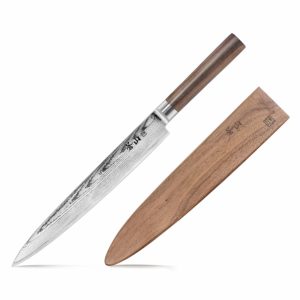
Although this is an expensive sushi knife, it is one of the best quality knives available and you are paying for a professional standard tool. The 10-inch handcrafted Japanese steel blade is razor sharp and can create ultra-thin slices of fish and meat for sashimi or sushi. The handle has a patent-pending design and is made from a blackwood. Even the walnut sheath that comes with this knife is a high-quality item.
Superior Blade:
This knife has a hard blade that is crafted from high-carbon Japanese steel. The edge is ultra-sharp and has a long life.
Unique Handle Design:
The stylish cylindrical handle is made from ultra-dense African blackwood using a unique patent-pending design. It looks smooth and sleek while also giving good grip and balance.
Quality Sheath:
This knife comes with a beautiful sheath that is made from walnut. Not only is this a visually pleasing item, but it also serves a practical purpose. It protects you from the blade of this sharp knife when it is not in use and also protects the knife’s blade from damage. This is a magnetic Saya-style sheath.
9. Masahiro Stainless Yanagiba
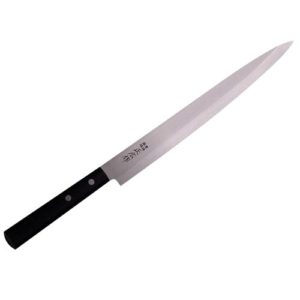
This Japanese sashimi knife has a blade that measures just under 11-inches, but the total length of the knife is just over 18-inches. The blade is made from a good quality stainless steel, so it will not rust and is very durable. The handle is made from plastic, which is easy to clean. This is quite a cheap sushi knife, so it is a good option for those on a budget.
Very Sharp:
Customers who have bought this knife claim that the sharpness of the knife can compete with expensive sushi knives they have bought.
Easy Maintenance:
The plastic of the handle means that this is a sanitary product that is easy to clean. As the blade is made from stainless steel, it will not rust or discolor, so there is not the need for regular maintenance of this knife.
Good Construction:
The good construction of this knife means that it is well balanced and easy to use.
10. Seki Gold Kotobuki St Sashimi Knife
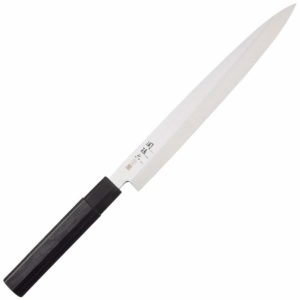
A lightweight and affordable product, this knife has a blade that is just under 10-inches and is made from molybdenum vanadium stainless steel. It has a sharp blade and tip that are ideal for precision cutting. The smart handle design offers good grip and ease of use.
Lightweight:
This knife weighs just 5.6 ounces, so it is a lightweight product that is easy to use for fast chopping motions.
Good Quality Blade:
This is a good sushi knife thanks to its sharp blade. Crafted from molybdenum vanadium stainless steel, it is durable, rust and stain-resistant, razor sharp, and has a good edge life.
Nice Handle:
The handle has an octagonal design that is easy to grip. It is made from laminated wood that is smart, sanitary, and easy to clean.
11. Global Two-Sided Sashimi-YO Slicer

For those who want a professional-standard knife, this is a good option. While it is an expensive sushi knife, the quality of this product and the results it can produce make it worth the extra expense. It is a lightweight and precisely balanced knife that is made of quality materials and is super sharp. The double-sided blade means you can use it easily with either hand and the grip on the handle makes it easy to hold.
Excellent Quality:
The blade of this knife is made from high-tech molybdenum vanadium stainless steel. This is a strong and durable material that is stain and rust-resistant.
Sharp Blade:
The sharpness of the blade is important when creating sushi and sashimi. The edge of this knife is face-ground with a long taper so that the edge will remain sharper for longer.
Dimpled Grip Handle:
Its stainless steel, molded handlehas dimples to give you a good grip when using and this increases safety.
12. Paderno World Cuisine Yanagi Sashimi Japanese Sushi Knife

Measuring 11.88 inches, this is a long knife that is good for cutting any size of fish or meat. It is manufactured in Italy using quality materials to replicate a traditional Japanese sushi knife. The sharp edge of the blade slices cleanly through raw fish and meat, while the handle gives good grip for safe use.
Good Grip:
This knife has a good grip because the handle is made from slip-resistant wood.
Long Blade:
It has a long, narrow blade that is made from a high-quality molybdenum vanadium stainless steel that is durable and gives maximum edge retention. The thin sharp edge makes cutting raw products easy.
Best Sushi Knives Sets – Product Reviews
If you have decided that you would prefer to buy a knife set, then here are three of the best sushi knife sets available.
1. Hiroshi Knives 4-Piece Sushi Knife Set

This is probably the best sushi knife set on the market now. It covers the basic needs of the amateur sushi enthusiasts and is one of the cheapest knife sets available. It includes the four most commonly used sushi and sashimi knives, so this is a versatile product. They are made from high-carbon steel with wooden handles.
Forged Blades:
Each of the knives in this set has a forged blade made from high-carbon steel that is ultra-hard and durable. The blades are hand sharpened and hand assembled.
Sturdy Handles:
The wooden handles on these knives give good grip. They are sturdy and durable, so will withstand wear and tear.
Versatility:
This is a versatile set because of the different knives include. These are an 8-inch gyutou, a 7-inch nakiri, a 6.5-inch santoku, and a 4.5-inch petty.
2. Mr. Takaaki Nakamura Japanese Kitchen Knife Set of 5
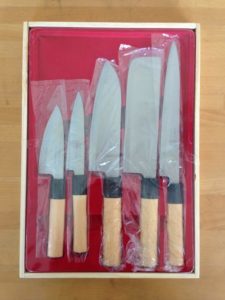
This is another affordable set of sushi knives for sushi and sashimi enthusiasts. The set contains five of the most commonly used knives, so this is a versatile product that will allow you to create great sashimi and sushi rolls. The set comes in a smart storage box where you can safely keep your sushi knife set when not in use.
Stainless Steel:
The blades on each of the five knives are made from a good quality stainless steel. This is a durable material that is rust-resistant and easy to sharpen.
Good Storage Box:
This set comes in a smart, wooden presentation box where you can safely store your knives together when not in use.
Precision Cutting:
According to customers, these knives are capable of precision cutting of the same level you would expect from much more expensive knives.
3. Happy Sales Set of Three Japanese Sushi Chef Knives
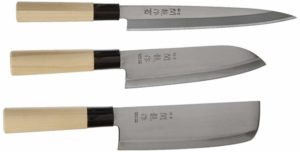
Contained in this set are three of the most commonly used sushi knives. This gives you the option to create a diverse range of sushi dishes using these tools. These affordable knives are made in Japan using high-quality materials for both the blades and the handles. It is the quality of these materials that make them easy to use and they will give you excellent results.
Three Knives:
Contained in this set are a sashimi knife, a santoku knife, and a nakiri knife. This will allow you to make the sashimi and sushi dishes of your choice.
Quality Materials:
The blades of these knives are made from high-carbon stainless steel, which is durable, sharp, and has a good edge life. The handles are made from a dense Japanese hardwood.
Dishwasher Safe:
Most sushi knives are not dishwasher safe and this means you must wash them by hand. However, these knives are dishwasher safe, so they are easy to keep clean.
A Buying Guide- Things to Consider When Choosing a Sashimi or Sushi Knife
Not all sashimi and sushi knives are the same, so there are some things you should consider when choosing these knives. The following is a guide of things to consider so that you can buy the best sashimi knife for cutting sushi.
Type of Knife
The most important thing to consider is the type of knife or knives you need to buy. There is a wide range of sashimi and sushi knives available and you may choose to buy a single knife or multiple knives. Consider the following:
- Think about how you will use the knives. Each knife has a specific purpose and you only need to buy the knives that suit the ingredients you use and the dishes you create.
- If you are buying for personal use in a home kitchen, you may prefer to choose just one of the most versatile sushi or sashimi knives rather than buying a range of knives.
- For professional chefs, you should consider buying several types of knife for different uses.
- If you want to start a basic collection, then three of the best types of knives to choose are probably a deba, a usuba, and a snatoku.
Materials
The two most common materials used for knives are stainless steel and carbon steel. Usually Western knives use stainless steel while Japanese knives use steel.
- There are three types of stainless steel used to manufacture knives. These include semi-stainless steel, powdered steel, and tool steel.
- There are also three types of carbon steel used to create Japanese knives. These are white steel, blue steel, super blue steel.
- Stainless steel is less likely to chip, can retain an edge for longer, and are are also tougher than carbon.
- Stainless steel is not as sharp as carbon steel, so it will not cut as cleanly, and they are the non-traditional option.
- The positives of carbon steel knives are they are traditional, sharper, more efficient, and easier to sharpen.
- The downsides of carbon steel knives are they are brittle, can rust, and not as tough as stainless steel knives.
Handles
The handles differ between Western and Japanese knives. So, you should think about which you prefer to use.
- Western handles have either a full or partial tang and a bolster.
- The handles of Western knives are often smaller but heavier
- Non-porous materials are used for Western knives, such s synthetics or resin-cured wood.
- Some chefs prefer Western handles as they are handle-heavy and allow them to grip the knife closer to the blade.
- Japanese handles are usually made from ho wood and friction fitted to a tang hidden in the handle.
- The junction between the blade and the handle of Japanese sashimi knives and Japanese sushi knives is a buffalo horn bolster.
- Other woods used in the handles of Japanese knives include ebony, cherry, yew, or chestnut.
- Japanese handles are lighter but larger than Western knives.
- Some chefs prefer to use Japanese knives because of the larger handle and the better balance when using the knife.
Construction
There are three different types of construction of knives. These are as follows:
Mono steel- These are thinner and harder to sharpen than laminated blades. They come in three varieties. Zenko is a stamped out blade, honyaki is forged from carbon steel, and a final variety is forged from a billet without differential hardening.
Laminated- There are two basic types of laminated Japanese sushi knives. The ni-ami has a jigane with hagane and the san-mai has a hagane that is sandwiched between jigane.
Patterned laminated- This is a variation of a laminated blade and the blades are formed with an artistic pattern.
Single Knives vs. Sets
In addition to deciding which type of knives to buy with what features, you should also think about whether to buy a single knife or a set. For some people, it is better to buy a single knife or to build up a collection of knives by buying the individual ones they need. Others prefer to buy a set with the most commonly used and versatile sushi and sashimi knives.
- If you only make sushi or sashimi at home occasionally, then you should just buy one versatile knife.
- Those who make sushi and sashimi regularly at home should consider getting a set with the most commonly used knives.
- Professional chefs who make sushi daily need a larger collection. They should consider buying a full set or individually selecting each of the knives they use.
- A full set needs more storage space and will cost more, so it is only worth buying all the knives if you use them regularly.
Price
When making any purchase, the price is one of the biggest considerations for most people. Think about the following points:
- The price of Japanese sashimi knives and sushi knives depends on many factors, including the quality, the materials, the style and design, the brand, and other features.
- The price does not always reflect the quality of the knives, but you can usually expect to pay more for the best sushi knives on the market.
- You can sometimes buy a cheap sushi knife that is just as good quality as an expensive sushi knife if you look out for a deal.
A Few Frequently Asked Questions
What Are Sashimi and Sushi Knives?
Sashimi and sushi knives are not the same thing as they are used for different purposes. To understand what these knives are, it is important to understand the difference between sashimi and sushi.
Sashimi is a Japanese delicacy of thinly sliced, fresh, raw meat or fish. This is sometimes served plain and sometimes marinated or flavored. Therefore, a sashimi knife is one that is thin with a sharp blade that can easily slice through the flesh of fish and meat.
Sushi is a dish which uses sushi rice as its main ingredient. Other ingredients that are added can include seafood, vegetables, and sometimes fruits. The ingredients are often rolled together before slicing into portions. This means there are several different preparation processes involved that each requires a different knife with different features.
The following is an overview of some of the characteristics of Japanese kitchen knives that distinguish them from Western knives:
- Japanese knives usually have a single bevel, while western knives have a double bevel.
- They are made from carbon steel rather than stainless steel.
- Japanese knives have a ho wood handle that is burned in and then friction fitted to a tang which is hidden. Western knives have both a bolster and wither a partial or full tang.
- The construction of the knives is either laminated or mono-steel.
- The blades are often thinner than Western knives, so they can cut finer slices.
- The blade edges are exceptionally sharp to achieve a clear cut.
- They are tough and durable with a good-quality edge with a long edge life.
What Are the Different Types of Sashimi Knives and Which Are the Most Widely Used?
There are several different types of sashimi knives used to create sashimi. These include:
- Taka hiki- This knife originates in Tokyo and it has a rectangular end. Most commonly, this knife is used to slice octopus.
- Yanagiba- The yanagiba is similar in style to the taka hiki. However, it has a pointed end and originates from Osaka. This is the most commonly used knife for sashimi making as it is the most versatile.
- Fugu hiki- These are used to thinly slice fugu, which is puffer fish. Due to the poisonous nature of these fish, only an experienced sushi chef is likely to use this knife as most people would avoid preparing this fish without knowledge and experience. The blade of this knife is thinner and more flexible than a yanagiba.
- Oroshihōchō- This is a knife that measures almost two-meters and it is used for slicing longer fish, such as American tuna.
- Hanchohōchō- This is a slightly shorter version of the oroshihōchō and it is also used for slicing longer fish.
What Are the Different Types of Sushi Knives and Which Are the Most Widely Used?
There are many different ingredients to make different types of sushi. This means that there are various preparation processes involving different ingredients. Each of these ingredients needs a knife with different qualities to prepare them properly. Therefore, any self-respecting Japanese sushi chef will have a set of the very best sushi knives that gives them the flexibility and versatility to create a diverse range of sushi dishes. Some of the most common types of knives for sushi include:
- Yanagiba- This is considered the standard sashimi knife as it is good for cutting both sashimi and sushi rolls, so it is a versatile knife. Its name means willow-shaped.
- Deba- This has a similar appearance to a meat cleaver. It is a sturdy knife that can cut through meat bones and fish cartilage.
- Santoku- The name means three virtues, and this is probably the most versatile of all the knives as it can cut vegetables, meat, and fish. Although it is now one of the most commonly used knives and is a standard item in many Japanese homes and kitchens, this is not a traditional Japanese knife.
- Usaba- This is the most commonly used knife for chopping vegetables. It is good for peeling and fine cuts.
However, there are many other types of sushi knives. These include:
- Gyuto- Used for both meat and vegetables, this knife is called the beef sword. Chefs use the heel of the knife to thrust-cut vegetables and the knife is also used to rock-chop stiff products. The tip of the knife is used to make finer cuts. When cutting meat, the knife is used in a back and forth sawing manner.
- Nakiri- This is a square-tipped vegetable knife with a flat edge and some have a tilted blade.
- Chuckabocho- Also known as the Chinese chef’s knife, it has a tall blade, a flat profile, and a short handle. They are used to cut denser ingredients and sometimes they are used to cut bone.
- Hankotsu- Only a professional chef or butcher would use these knives as they are used for butchering hanging meat.
- Petty- This is a small pairing knife that is used alongside the gyuto knife or on smaller produce.
- Suijhiki- These are used to draw cut meat.
- Usuba- A thin blade with a flat profile that is used for push cutting and for cutting thin sheets. There are both square-tipped and round-tipped options of these knives.
- Magurokiri- Available in a range of sizes, this knife is a tuna knife that is used to cut parallel or perpendicular to the tuna.
- Kiritsuke- This is a hybrid knife that combines the height and profile of the usuba with the length of the yanagiba.
- Honesuki- It is used to debone chicken. Garasuki is a thicker version of this knife that can cut through bones.
- Unagisaki- There are several variants of this eel knife, including kanto, Kyoto, Kyushu, and Nagoya.
- Mukimono- This is another knife used in vegetable preparation.
- Hamokiri- A specialist knife, this is used in the preparation of pike conger.
- Sobakiri- These are used to create soba noodles from buckwheat.
Are There Other Knives That You Can Use to Make Sushi or Sashimi?
In theory, you can use other sharp knives to make sushi and sashimi. However, they will probably not slice as cleanly and create the thin slices needed to make authentic sashimi and sushi. If you create sushi and sashimi regularly at home or you are a professional chef that creates these dishes in your workplace, then it is much better to buy authentic knives.
How to Use Sashimi Knives to Cut Sushi
Creating sushi with Japanese sushi knives is an art that it takes many professional chefs years to perfect. The following is a basic guide for how to cut sushi using your sashimi knives.
- Holding the knife- Don’t wrap your whole hand around the handle. Instead, place your thumb on the side of the base of the blade and your bent index finger on top the base of the blade. Use your other three fingers to wrap around the handle. Your hand should be in the shape of a paw. This will give you greater control over using the knife.
- Your cutting hand- Your cutting hand is the hand you use to hold the food. You should hold this hand like a paw with your fingers and thumb tucked in. You will use the knuckle of your thumb to rest on the cutting board to make sure it doesn’t move, and your fingers will hold the food.
- Holding the food- Your thumb and little finger will rest on the cutting board on either side of the food while the three middle fingers will act as a guide for slicing. Your middle finger must be perpendicular to the board as the sushi knife will slide against this finger when slicing.
- Lining up the knife- You do not necessarily need the knife perpendicular to the cutting board as this can cause you to lean. It is better to have the cutting board to an angle.
- Starting the cut- Start the cut with the heel end of the knife before pulling towards yourself. Always keep the edge of the blade lower than the knuckle on your middle fingerbut use your middle finger to line up the cut.
- Precision cutting- As you pull the blade towards yourself begin to angle the heel end upwards and the tip downwards. This means the tip end finishes the cut and creates a precision slice.
- Further slices- you will gradually move your fingers along the food by an equal distance each time to make your second and consequent slices. With each slice, you will use your middle finger to line up the cut.
For more tips on using sashimi knives to cut sushi, you should watch this video:
Final Verdict
Buying sushi and sashimi knives is a good idea if you enjoy creating and eating Japanese cuisine or if you create these dishes in a professional capacity. There are some fantastic products available to choose between and each has its own features, pros, and cons.
One of the best sushi knives on the market now is the Yoshiri VGYA270SH Hongasumi Yanagi Knife. This is a well-constructed knife with good balance and made from high-quality materials. It cuts cleanly and precisely, which is ideal for making sushi and sashimi.
Another good option if you want the best sashimi knife is the JapanBargain S1560 Japanese Yanagiba Sashimi Knife. This is a top-quality knife that performs well. It is also easy to maintain and comes with a stylish storage case.
If you prefer to buy a sushi knife set, one of the best sushi knife sets available now is the Hiroshi Knives 4-Piece Sushi Knife Set. This quality set gives you the versatility to create a range of sashimi or sushi dishes and it comes in a smart storage box.
![15 Best Sashimi/Sushi Knives – Buying Guide [2025]](https://knivesadvisor.com/wp-content/uploads/2018/11/Best-Sashimi-and-Sushi-Knives.jpg)
